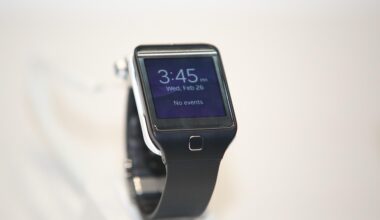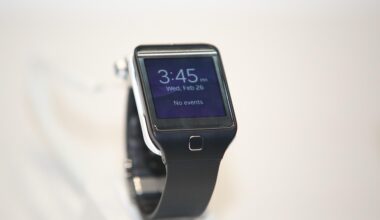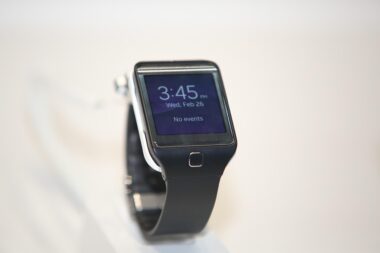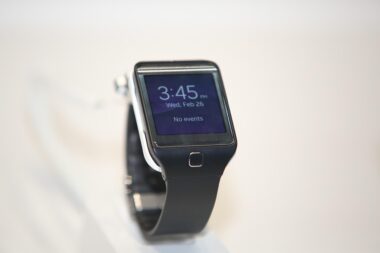Using Wearable Technology in Fitness Challenges
Wearable technology has transformed the fitness landscape significantly, especially in fitness challenges. These devices monitor vital statistics and offer features that enhance engagement and motivation. Popular wearables include smartwatches, fitness trackers, and heart rate monitors. By tracking heart rate, steps, calories burned, and sleep quality, participants gain valuable insights into their performance. Moreover, they can set specific goals based on this data. This level of personalization is vital for maintaining motivation throughout any fitness challenge. Furthermore, wearables encourage friendly competition, as participants can share their statistics with fellow challengers. Seeing how others are progressing can fuel a competitive spirit. Additionally, many of these devices sync with mobile apps, allowing users to analyze their data over time, fostering a comprehensive understanding of progress. Another benefit of using wearables in fitness challenges is injury prevention. Monitoring heart rate and exertion levels helps participants avoid overdoing their workouts. The growing community using wearables also contributes to social motivation. Participants can encourage one another in online forums, leading to increased accountability. Thus, wearables not only track metrics but also create a supportive network for individuals engaging in fitness challenges.
The Role of Data in Fitness Challenges
The data gathered by wearable technology holds immense potential for enhancing the effectiveness of fitness challenges. First and foremost, statistics can pinpoint individual strengths and weaknesses, tailoring training programs accordingly. For instance, if a participant consistently struggles with endurance, personalized workouts can be implemented to focus on cardiovascular improvement. This tailored approach ensures accountability and sustainable growth. Moreover, wearable technology provides real-time feedback, fostering immediate responses to performance metrics. This helps participants adjust workouts promptly if they are not meeting their goals. By analyzing these data trends, participants can make informed decisions about their workout regimens. Furthermore, wearables facilitate long-term progress tracking, allowing users to set and achieve specific targets. This feature is particularly beneficial for challenges designed to last weeks or months. Participants can gauge their endurance, strength, and flexibility advancements, creating a sense of accomplishment. The integration of social sharing platforms with wearables can amplify motivation as friends can post achievements. Overall, the data generated by wearables not only enhances personal fitness journeys but also enriches collective challenges, making them more engaging and successful.
In addition to physical data, wearable technology also enhances mental wellness during fitness challenges. Regular tracking encourages participants to cultivate a disciplined routine, which in turn, boosts mental resilience. For instance, setting daily step goals promotes consistency, turning physical activities into habits. Furthermore, many wearable devices offer mindfulness features, such as guided breathing exercises or meditation reminders. This holistic approach contributes to both mental and physical health, creating a well-rounded fitness challenge experience. Social interaction is another vital mental aspect, as wearables often include community features, enabling users to connect. Friendly competitions, badges, or leaderboards can significantly enhance motivation as participants strive to achieve goals. Being part of a community fosters accountability while providing support during tougher days. Participants often find that sharing goals and achievements leads to a stronger commitment to the challenge. Additionally, the gamification aspect can make workouts more enjoyable. Users can earn rewards for meeting milestones, turning fitness into an engaging game. Therefore, integrating mental wellness components alongside physical monitoring points to a smarter, more comprehensive approach to fitness challenges.
Selecting the Right Wearable Device
Choosing the ideal wearable device for fitness challenges can significantly impact participants’ experiences and results. First, individuals should consider their specific fitness goals. For example, runners may prioritize heart rate monitors with GPS functionality. In contrast, someone focused on strength training might benefit from devices that track reps and sets. Another essential factor is compatibility with existing fitness apps and platforms. Many wearables seamlessly integrate with popular fitness apps, facilitating trend analysis and social engagement within the fitness community. Users should also consider battery life, as long-lasting devices ensure uninterrupted monitoring during extended workouts or challenges. Comfort and design are necessary too, as cumbersome devices may hinder performance. Wearables come in various forms, from wristbands to clip-ons, allowing users to select what suits them best. Price and functionality should also be considered, as some devices offer extensive features at higher costs. Researching reviews and ratings can help gauge user satisfaction and reliability. Lastly, potential users should think about the attached community surrounding the wearable, as peer interaction can significantly enrich the fitness challenge experience.
Incorporating an element of fun is essential in fitness challenges, and wearable technology can facilitate that through challenges and games. Many apps linked to wearables allow participants to join fun competitions based on their activity levels. These features can include fitness challenges such as step counts, distance tracking, or even weekly exercise goals. Participants can engage in various interactive formats, promoting healthy competition among peers. This enhances motivation, as users push themselves to elevate their performance. Furthermore, introducing rewards for achieving these goals can turn doing workouts into a game. This gamification fosters excitement around completing daily workouts, leading to better adherence to fitness routines. Moreover, incorporating playful elements, like virtual badges or leaderboard positions, can create an engaging environment promoting camaraderie. Comparisons to friend metrics enhance motivation, as friendly rivalry often encourages people to reach new levels. Additionally, wearable technology can facilitate social media interactions, allowing users to share achievements widely. Incorporating playful features can transform mundane routines into invigorating experiences, inspiring commitment to fitness journeys and making fitness challenges enjoyable and productive.
Potential Challenges with Wearable Technology
Despite the numerous benefits of incorporating wearable technology in fitness challenges, potential challenges exist. One significant issue concerns the accuracy of data collected by these devices. Some wearables might not provide real-time data accurately, which can mislead participants regarding progress. It’s crucial for users to review data critically and align it with personal experiences. Moreover, the overwhelming amount of data can lead to information fatigue. Participants might find it challenging to discern what metrics matter most, hindering their focus on meaningful improvements. Additionally, technical issues, such as syncing failures or app bugs, can disrupt the intended experience. Not all users are technologically inclined, which can complicate device use and data interpretation. Also, the reliance on technology can overshadow the importance of intuitive body listening, leading to participants ignoring their physical cues. Privacy concerns regarding data storage and sharing from wearables are also essential considerations. Participants should thoroughly read privacy policies and understand their data’s usage. Acknowledging these potential challenges ensures that users can maximize the benefits of wearable technology effectively in their fitness challenges.
As wearable technology continues evolving, innovations in this field promise exciting enhancements for fitness challenges. Features like advanced analytics and artificial intelligence integration will offer even deeper insights into performance metrics. For instance, prospective wearables may predict fatigue levels from past data trends, advising users when to rest. Additionally, innovations may introduce personalized coaching based on user data analysis, helping individuals achieve specific goals more effectively. Moreover, improvements in connectedness through smart home integrations or virtual reality may redefine how challenges are conducted. Participants could engage in immersive experiences while tracking their progress seamlessly. Future wearables might also provide advanced wellness tracking, monitoring mental health indicators and suggesting mindfulness activities. Another exciting prospect is the growth of community-driven platforms, where users can seamlessly connect and foster relationships. Accelerating advancements in these features emphasize the significance of community engagement alongside personal fitness journeys. Furthermore, sustainability efforts may lead brands to create greener wearable technology. Such advancements not only enhance the effectiveness of fitness challenges but also redefine how users engage with their fitness journeys.





